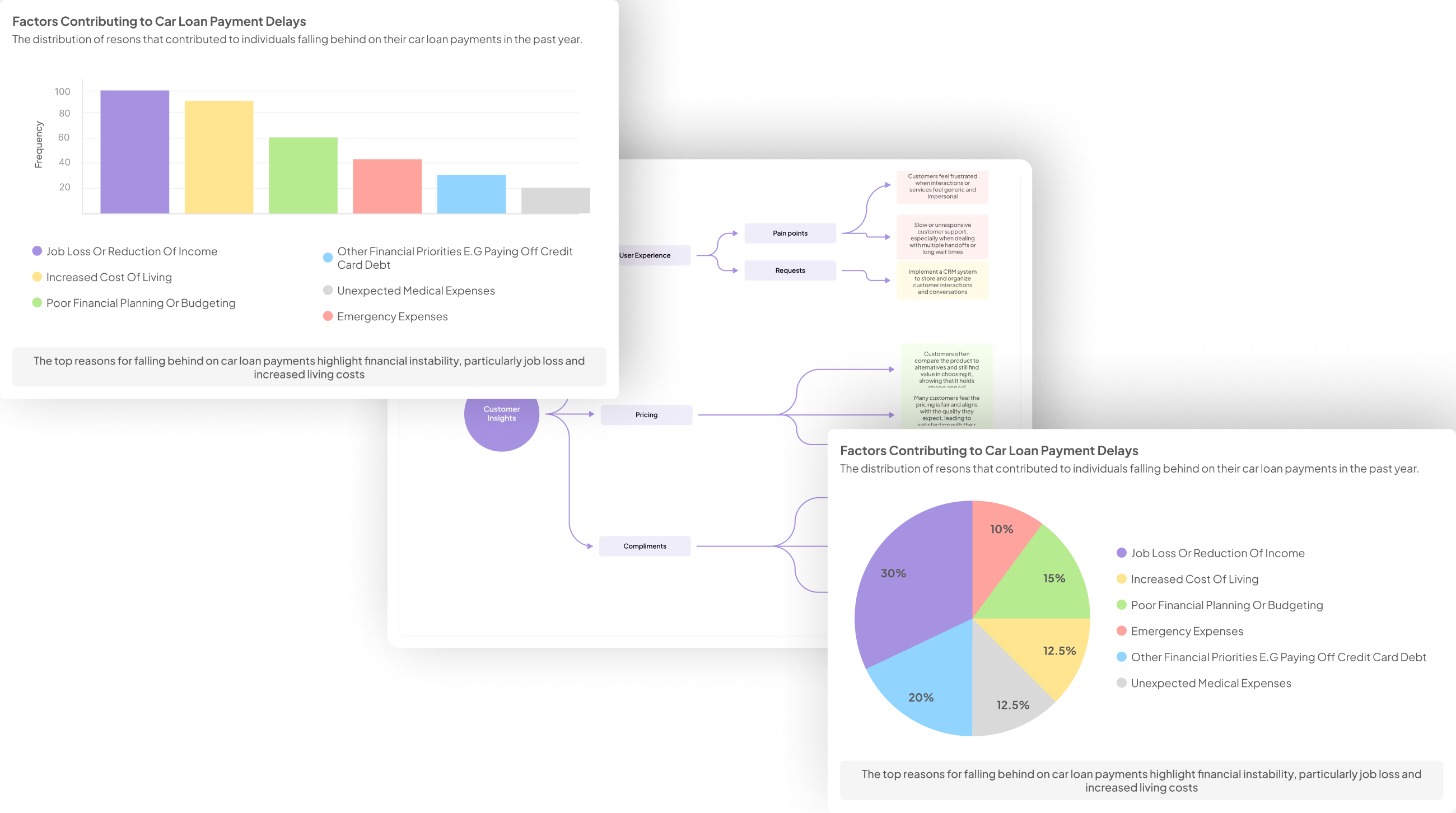How to Analyze brainstorming sessions
-
Bella Williams
- 10 min read
Brainstorming sessions are often a vibrant mix of creativity and collaboration, but how do you measure their effectiveness? Introduction to Brainstorming Evaluation Techniques focuses on providing structured methods that allow for meaningful analysis of these often-chaotic gatherings. By integrating evaluation methods, teams can transform raw ideas into actionable insights, ensuring that every brainstorming effort yields value.
Effective evaluation techniques serve to illuminate strengths and weaknesses in the brainstorming process. They help in identifying which ideas resonate most with participants and highlight areas for improvement in group interaction. With the right approach, you can harness the full potential of brainstorming sessions and foster an environment that encourages innovative thinking and collective problem-solving.
Generate visualizations from your qualitative data. At Scale.

Identifying Key Brainstorming Evaluation Techniques
To effectively analyze brainstorming sessions, identifying key brainstorming evaluation techniques is essential. Start by establishing clear evaluation criteria that can guide your assessment process. Criteria could include the quality of ideas generated, the diversity of perspectives, and the overall engagement levels of participants.
Next, utilize a structured method to collect and organize data during the session. This could involve recording ideas on a digital board or using collaborative software. After the session concludes, evaluate the generated ideas against your predetermined criteria. A methodical approach ensures a comprehensive assessment, revealing strengths and areas for improvement in future sessions. Furthermore, consider how well the group dynamics contributed to participation and idea flow, as understanding these interactions can significantly impact overall effectiveness. By combining these techniques, you create a robust framework for analyzing brainstorming sessions, leading to more fruitful outcomes and innovative solutions.
Step 1: Setting Criteria for Success
Defining clear criteria is essential for successful brainstorming evaluation. Begin by identifying the primary goals of your session, as these goals will shape the evaluation process. Focus on key aspects such as idea originality, feasibility, and relevance to the overarching objective. Establishing these criteria upfront allows participants to align their contributions and helps streamline the decision-making process later on.
Next, consider how to quantify and categorize the ideas generated during the session. Criteria can include metrics for creativity, potential impact, and even team collaboration. By employing effective brainstorming evaluation techniques, you ensure that every idea is assessed fairly and comprehensively. This structured approach not only aids in identifying the best ideas but also fosters an inclusive environment, encouraging creativity and participation from all team members. Ultimately, clear criteria will serve as a guide throughout the evaluation process, leading to successful outcomes.
Step 2: Collecting and Organizing Data
To successfully analyze brainstorming sessions, the process of collecting and organizing data is critical. Begin by gathering all the notes, recordings, and visual aids generated during the session. This data will serve as the foundation for the evaluation process, where patterns and key themes can be identified. Encourage participants to contribute any additional insights or feedback post-session to enhance the information pool.
Once collected, organizing this data is essential for clarity and ease of analysis. Group related ideas, categorize feedback, and highlight recurring suggestions. Utilizing tools such as spreadsheets or specialized software can streamline data visualization. This structured approach is vital for applying effective brainstorming evaluation techniques, allowing you to recognize patterns and derive actionable insights. Ultimately, well-organized data will lead to a more effective analysis of the session, guiding future brainstorming efforts towards achieving better outcomes.
Evaluate Performance on Customer Calls for Quality Assurance.
Analyzing Brainstorming Session Outcomes with Brainstorming Evaluation Techniques
To effectively analyze brainstorming session outcomes, it’s essential to apply appropriate evaluation techniques. These techniques help determine not only the number of ideas generated but also their quality and relevance. By establishing clear criteria prior to the session, participants can focus on producing valuable contributions. Once ideas are documented, categorization can facilitate a structured discussion on their merits.
Two critical pointers to consider are measuring idea quality and quantity, as well as assessing group dynamics and participation. Measuring idea quality involves assigning value to each suggestion based on specific pre-set criteria. This can include originality, feasibility, and potential impact. On the other hand, assessing group dynamics involves observing how well team members engage with one another. Understanding interactivity can reveal whether certain individuals dominate discussions or if quieter members need encouragement. Both aspects are vital in evaluating the overall effectiveness of your brainstorming sessions.
Step 3: Measuring Idea Quality and Quantity
To effectively measure idea quality and quantity in brainstorming sessions, it's vital to develop a structured approach. Begin by assessing each idea against predetermined criteria, such as feasibility, relevance, and originality. This helps streamline the evaluation process and allows the team to focus on high-impact concepts. Utilize qualitative feedback, such as comments from participants, to supplement this quantitative analysis, providing a fuller picture of each idea's potential.
Next, employ a scoring system to quantify the ideas generated. This could involve assigning points based on specific attributes or using methods like weighted scoring to prioritize the most promising suggestions. Gathering this data allows for a more nuanced comparison of each idea, facilitating informed decision-making. In doing so, teams can foster a creative environment that not only values the number of ideas but also their quality, ultimately leading to more successful outcomes and innovative solutions.
Step 4: Assessing Group Dynamics and Participation
Understanding group dynamics and participation is crucial for effective brainstorming sessions. Observing how group members interact provides insights into how ideas are generated and refined. High engagement levels among participants often lead to an explosive flow of ideas, fostering creativity and collaboration. On the other hand, if certain individuals dominate the conversation or others hesitate to share, it can stifle the brainstorming process.
To analyze these dynamics, consider factors such as participation methods, communication styles, and the balance of contributions among team members. Utilize brainstorming evaluation techniques like anonymous feedback forms post-session to gauge individual perspectives on group dynamics. This can reveal underlying issues such as hesitance to speak up, potential biases, or even groupthink tendencies. By assessing these elements, you can facilitate more inclusive discussions in future sessions, ultimately enhancing the quality of ideas generated and ensuring that all voices are heard.
Conclusion on Effective Use of Brainstorming Evaluation Techniques
Effective use of brainstorming evaluation techniques greatly enhances the productivity of sessions. By systematically assessing contributions, you can identify valuable ideas and areas needing improvement. This structured approach fosters better communication among team members and guides further discussions, ensuring everyone feels heard and valued.
Additionally, implementing clear evaluation criteria not only streamlines the analysis process but also promotes a culture of accountability. By consistently applying these techniques, organizations can maximize the potential of their brainstorming endeavors, ultimately leading to innovative solutions and strategic growth.







